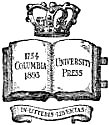CIVIL WAR AND RECONSTRUCTION
IN ALABAMA

CIVIL WAR AND RECONSTRUCTION
IN
ALABAMA
BY
WALTER L. FLEMING, Ph.D.
PROFESSOR OF HISTORY IN WEST VIRGINIA UNIVERSITY

New York
THE COLUMBIA UNIVERSITY PRESS
THE MACMILLAN COMPANY, Agents
LONDON: MACMILLAN & CO., Ltd.
1905
All rights reserved
Copyright, 1905,
By THE MACMILLAN COMPANY.
Set up and electrotyped. Published October, 1905.
Norwood Press
J. S. Cushing & Co.—Berwick & Smith Co.
Norwood, Mass., U.S.A.
TO
MY WIFE
MARY BOYD FLEMING
PREFACE
This work was begun some five years ago as a study of Reconstruction inAlabama. As the field opened it seemed to me that an account ofante-bellum conditions, social, economic, and political, and of the effectof the Civil War upon ante-bellum institutions would be indispensable toany just and comprehensive treatment of the later period. Consequently Ihave endeavored to describe briefly the society and the institutions thatwent down during Civil War and Reconstruction. Internal conditions inAlabama during the war period are discussed at length; they are important,because they influenced seriously the course of Reconstruction. Throughoutthe work I have sought to emphasize the social and economic problems inthe general situation, and accordingly in addition to a sketch of thepolitics I have dwelt at some length upon the educational, religious, andindustrial aspects of the period. One point in particular has beenstressed throughout the whole work, viz. the fact of the segregation ofthe races within the state—the blacks mainly in the central counties, andthe whites in the northern and the southern counties. This division of thestate into “white” counties and “black” counties has almost from thebeginning exercised the strongest influence upon the history of itspeople. The problems of white and black in the Black Belt are not alwaysthe problems of the whites and blacks of the white counties. It is hopedthat the maps inserted in the text will assist in making clear this point.Perhaps it may be thought that undue space is devoted to the history ofthe negro during War and Reconstruction, but after all the negro, whetherpassive or active, was the central figure of the period.
Believing that the political problems of War and Reconstruction are ofless permanent importance than the forces which have shaped and areshaping the social and industrial life of the people, I have confined thediscussion of politics to certain chapters chronologically arranged, whilefor the remainder of the book the topical[Pg viii] method of presentation has beenadopted. In describing the political events of Reconstruction I have inmost cases endeavored to show the relation between national affairs andlocal conditions within the state. To such an extent has this been donethat in some parts it may perhaps